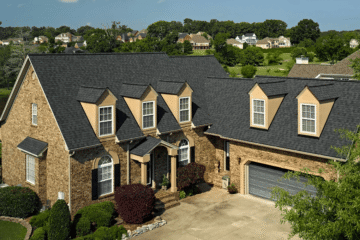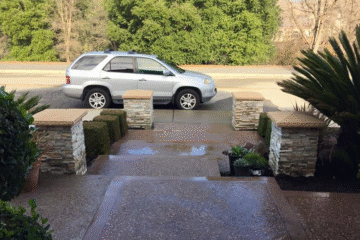15 Most Popular Roof Types and Their Characteristics
Roofs are an architectural essential, a crowning glory that not only protects our homes but also adds character and style. From classic designs to modern innovations, the world of roofing encompasses a stunning array of options. Each type brings its unique features, reflecting regional influences, climate considerations, and aesthetic preferences.
Gable Roofs: The Timeless Classic
Gable roofs, also known as peaked or pitched roofs, are a timeless classic. With two sloping sides meeting at a central ridge, they create a simple, triangular shape. This design facilitates effective water drainage and offers ample attic space. Gable roofs suit various architectural styles and provide excellent ventilation, making them a popular choice across the globe.
Hip Roofs: Balance and Stability
Contrasting the gable roof, hip roofs slope on all four sides, forming a gentle slope without vertical ends. This design provides durability and better stability against strong winds and hurricanes. Hip roofs perfectly combine aesthetics with functionality, making them a common sight in many residential constructions.
Flat Roofs: Minimalistic Elegance
Despite the name, flat roofs have a slight pitch for water drainage. They exude minimalistic elegance and provide additional outdoor living space when utilised properly. While common in modern architecture, they require proper drainage systems to prevent water accumulation.
Skillion Roofs: Modern Simplicity
Also known as shed or lean-to roofs, skillion roofs are characterised by a single slope. Their contemporary and minimalist design suits modern architectural styles. Skillions effectively shed water and are ideal for regions with high rainfall.
Butterfly Roofs: Aesthetic and Eco-friendly
The butterfly roof design slopes downward inwards, creating a central valley. This unique shape collects rainwater for reuse, making it an eco-friendly choice. Butterfly roofs are architecturally striking and often used in modern, eco-conscious designs.
Jerkinhead Roofs: Subtle Twist on Gables
Jerkinhead roofs, also called clipped gables or half-hipped roofs, resemble gable roofs with clipped peaks. They offer a subtle twist to the traditional gable design while providing increased stability against strong winds.
Shed Roofs: Functionality in Simplicity
Simple yet functional, shed roofs have a single slope, resembling a lean-to structure. They are practical for additions to existing structures or standalone buildings like sheds, providing cost-effective and straightforward roofing solutions.
Saltbox Roofs: Colonial Charm
Saltbox roofs have an asymmetrical design with one side having a shallower slope than the other. Originating from colonial America, they offer a unique aesthetic and practicality by providing extra space for a full second floor on one side.
Bonnet Roofs: Traditional Elegance
Bonnet roofs, also known as kicked-eaved roofs, feature a double slope with the lower slope being steeper than the upper one. They exude traditional elegance and offer additional protection to windows and walls from the elements.
Dome Roofs: Architectural Marvels
Dome roofs are hemispherical or onion-shaped structures often seen in religious or monumental buildings. Their engineering marvels provide strength and durability, making them iconic architectural elements around the world.
Sawtooth Roofs: Industrial Innovation
Sawtooth roofs comprise a series of ridges with vertical or near-vertical surfaces paired with windows or skylights. Originating from industrial architecture, they allow abundant natural light and ventilation, ideal for factories and modern commercial spaces.
Pyramid Roofs: Symmetry and Stability
As the name suggests, pyramid roofs form a pyramid shape with four equal sides sloping towards a central point. Their symmetrical design provides excellent stability and makes a striking architectural statement.
Clerestory Roofs: Light and Airy Elegance
Clerestory roofs feature a raised section with windows along the top part of a longer roof. They allow ample natural light and ventilation, enhancing energy efficiency and creating an airy, inviting interior space.
Mansard Roofs: French Flair and Versatility
Mansard roofs, originating from 17th-century France, are known by a double slope on all four sides. The lower slope tends to be steeper, while the upper one is almost flat. This design maximises living space and offers architectural versatility, allowing for the addition of extra rooms or attic space.
With their double slopes on all four sides, these roofs can be more challenging to install due to their complex framing and the need for precision in constructing the multiple angles. In this scenario, hiring MLR Slate Roofing’s services ensures the professional installation of such intricate roofs.
Gambrel Roofs: Barn-Inspired Charm
Similar to mansard roofs, gambrel roofs feature two slopes on each side. However, these slopes are not as steep as the ones on a mansard roof. Gambrel roofs, reminiscent of traditional barns, offer increased headroom and storage space, making them a charming choice for homes and barn conversions.
Conclusion
The diverse world of roofs presents a multitude of choices, each with its unique blend of functionality, aesthetics, and architectural significance. Understanding the characteristics and purposes behind these 15 popular roof types will help you pick the perfect choice for your property.




